Hits: 90


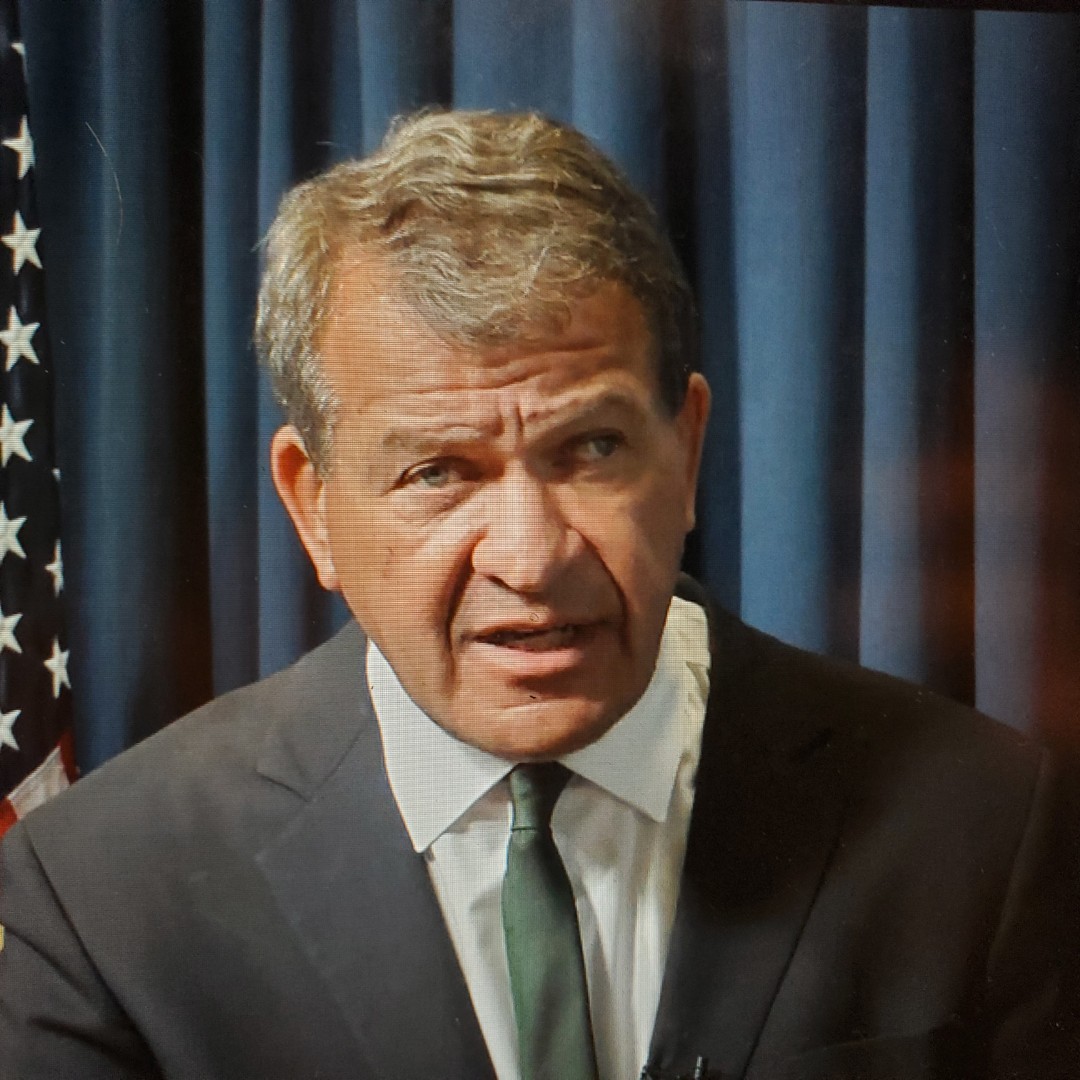
Hits: 90


Hits: 106
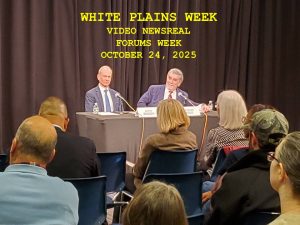
JOHN BAILEY REPORTS ON THE LEAGUE OF WOMEN VOTERS ELECTION MAYOR OF WHITE PLAINS FORUM JUSTIN BRASCH AND LEONARD LOLIS TELL THEIR SIDES OF THE STORY.
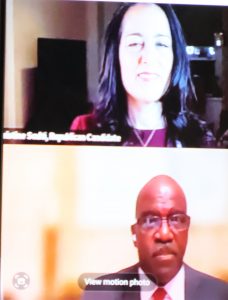
THE COUNTY EXECUTIVE FORUM CHRISTINE SCULTI AND KENNETH JENKINS CANDIDATES FOR COUNTY EXECUTIVE wESTCHESTER AT THE CROSSROADS

THE WHITE PLAINS COMMON COUNCIL FORUM CANDIDATES
WILL FLORES, RICHARD PAYNE ROBERTO RIPARI JOHN CAMBIERI,
EVELYN SANCHEZ AND NICK WOLFF.
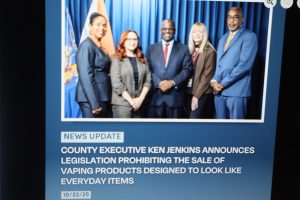

SATURDAY NIGHT LIVE AT THE WHITE PLAINS LIBRARY FOUNDATION 120 ATTEND

COVID NEW CASES RUNNING 36% BELOW LAST OCTOBER IN WESTCHESTER
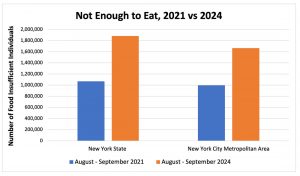
OVER 1,600,000 STILL COUNTED AS HUNGRY IN WESTCHESTER LITTLE PROGRESS IN FEEDING THE PERPETUALLY HUNGRY.

WHITE PLAINS HIGH SCHOOL INDUCTS 4 INTO ITS HALL OF FAME

DANIEL SLEPIAN, AWARD WINNING JOURNALIST with nbc news class 1988 JONETTE MINES 1978 ,JUNETEENTH HERITAGE COMMITTEE LEADER WPHS SOCIAL STUDIES TEACHER SUSAN ALTMAN, 1964, AND REAL ESTATE EXECUTIVE CARL AUSTIN, ’58 PHOTO BY WHITE PLAINS HIGH SCHOOL, USA

THIS WEEK JOHN BAILEY INTRODUCES A NEW WEEKLY COMMENTARY:
PERSPECTIVES 26
IN THE ERIC SEVEREID TRADITION
JOHN BAILEY AND THE NEWS YOU NEED TO KNOW
THIS WEEK EVERY WEEK
ON WHITE PLAINS WEEK
SINCE 2001 A.D. 24 YEARS
YOUR EARLY WARNING NEWS SYSTEM
KEEPING YOU INFORMED, FOREWARNED FOREARMED
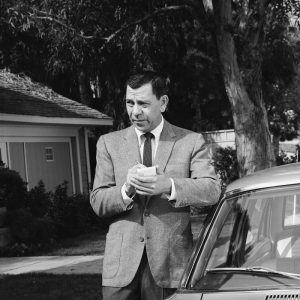
“JUST THE FACTS, MA,AM”
Hits: 1

TWO WEEKS TO THE ELECTION
MR. BRASCH ON
WHERE THE GALLARIA CITY STANDS NOW IN APPROVAL PROCESS
INFORMING THE PUBLIC MORE IN ADVANCE OF DEVELOPMENTS
THE INTERGENERATIONAL COMMUNITY CENTER
AFFORDABLE HOUSING AVENUES OF OPPORTUNITY TO INCREASE PACE OF AVAILABILITY
PREPARING FOR A 15,000 INCREASE IN WHITE PLAINS POPULATION
PUBLIC SAFETY
ADDRESSES CURRENT CONCERNS
AND MORE WITH JOHN BAILEY ON PEOPLE TO BE HEARD
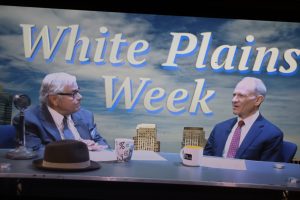
PEOPLE TO BE HEARD
THE PROGRAM
WHERE PEOPLE WHO HAVE SOMETHING TO SAY
HAVE THEIR SAY
THEIR WAY
11TH YEAR ON THE AIR
AROUND THE WORLD
Hits: 98
Enjoying this newsletter? Why not share it with a friend? Where NYC’s mayoral candidates stand on city-run groceriesAs the NYC mayoral race nears Election Day, I break down each candidate’s plan to address food insecurity and city-run groceries.
I’m back on the New York health beat after a week of global biosecurity workshops at the WHO and the UN (a huge thank you and shoutout to the Johns Hopkins Emerging Leaders in Biosecurity program!)—and a much-needed vacation. Conversations ranged from cross-border collaboration to public health surveillance and crisis communication. But I’m still thinking about one moment in particular: standing in front of the UN inscription from the 1948 Universal Declaration of Human Rights: “All human beings are born free and equal in dignity and rights.” It was a powerful reminder that public health isn’t just global, it’s local. What we build here in New York echoes far beyond our borders. And the basics still matter. Dignity, rights, and health begin with access to the essentials: housing, healthcare, and food. So let’s talk about food—specifically, city-owned grocery stores, which have come up repeatedly in the New York City mayoral race. Through FAQs, I’ll break down what they are, their track records in other cities, and where mayoral candidates stand. (During the primary election, I broke down some of the health-related topics candidates supported or opposed here.) And as a reminder, the city’s mayoral general election is less than two weeks away! Here are key dates to get on your calendars:
Let’s jump in. What are city-owned grocery stores?City-owned groceries, sometimes called “city-run groceries” or “public option groceries,” are supermarkets owned or operated by a city. Because of city ownership and operation, these stores often don’t need to pay rent or property taxes, and can buy foods wholesale, reducing overhead costs and increasing savings for shoppers. Cities can also support them with free utilities or direct subsidies. If the city itself owns the building or land, it’s automatically exempt from property taxes—publicly owned property used for a public purpose isn’t taxed under New York State law. When a municipality owns and operates a facility (like a library or firehouse), it doesn’t pay taxes to itself. Why is this a public health issue?A major goal of establishing city-owned groceries is to make food, and importantly nutritious foods, more accessible.
Food prices in New York City have soared, rising faster than the national average, up 56% between 2012 to 2023, compared to 46% nationally. (Income has also increased in the city, but it’s not keeping up with climbing food costs.) At the same time, food insecurity—when someone doesn’t have enough to eat at least some of the time—affects 1.2 million New Yorkers in the city. This is up 76% since 2021, with 1 in 6 households with children lacking enough to eat. The figure is higher than the 55% increase seen nationwide.
Figure from Hunger Free America. In NYC, rates are highest in the Bronx, where 1 in 5 residents and 1 in 3 children experience food insecurity. Staten Island has the lowest, with 11.5% of residents experiencing this problem. This isn’t just a big city issue. Across New York state, 1 in 8 (12.5%) of residents lived in food insecure households from 2021 to 2023, including 1 in 6 children. On top of that, cuts to the SNAP program in the “Big Beautiful Bill”—signed into law over the summer—will likely further exacerbate food insecurity in New York, as they reduce food assistance for low-income families. But the issue runs deeper than not having the income to pay for enough food. Many neighborhoods don’t even have grocery stores. Several New York neighborhoods are considered “food deserts”—where it’s difficult to buy healthy, nutritious food at an affordable price. These deserts often occur when large grocery companies avoid investing in lower-income neighborhoods because they have less purchasing power compared to wealthier neighborhoods, despite high demand for groceries. A way to measure this in NYC is to look at the ratio of bodegas to supermarkets across neighborhoods. The Bronx, which has the highest food insecurity in the city, has about 35 bodegas per 1 supermarket.
Figure from Paroma Soni at NYCityLens. With these challenges in mind, mayoral candidates are proposing various solutions to address food insecurity and improve access to healthy, affordable food across the city. What are the candidates proposing?MamdaniZohran Mamdani, an assembly member and mayoral hopeful, has proposed opening five city-owned stores (one in each borough) at an estimated cost of $60 million. The idea is to place them in areas where private grocers won’t go, sell food closer to wholesale cost, and exempt them from rent and property taxes. CuomoFormer Gov. Andrew Cuomo has opposed city-owned groceries, and instead proposes a $250 million targeted subsidy program for about 350,000 New Yorkers whose income is just above SNAP eligibility (around 131 to 150% of the federal poverty line). Under his plan, benefits would scale by income—roughly $1,200 a year for a family at the low end. His rationale is that aid should go directly to families, not into running a government grocery chain. He also believes that city-owned grocery stores could undercut or compete with small grocers and bodegas. This puts Cuomo in contrast to Mamdani’s approach. He prefers benefits that follow families in specific income brackets, while Mamdani’s plan aims to shift the supermarket structure itself. SliwaRepublican candidate Curtis Sliwa has criticized the public grocery store model as government overreach. His proposal to combat food insecurity does not detail specific plans, but includes pushing for bridge funding to cover cuts to the SNAP program, reducing red tape for food distributors, and improving access to wholesale markets for small grocers. Does NYC already have city-owned markets?Yes. The city already runs Essex Market on the Lower East Side, La Marqueta in East Harlem, and Moore Street Market in Williamsburg. These are smaller public markets rather than full-service supermarkets, but they provide a precedent. There are three other public retail markets, which are directly managed by the housed tenants. The city’s Economic Development Corporation already has tax and zoning subsidies granted to developers and grocers willing to open in so-called food deserts. In other words, public dollars already flow to the grocery sector in NYC—just indirectly. Where else have city-owned groceries been tested?Most city-owned grocery stores in the U.S. have been in rural communities:
Some big cities are beginning to experiment with city-owned grocery stores.
Would city-owned grocery stores hurt small businesses?Potentially. City-owned grocery stores could move customers from bodegas and small supermarkets. But supporters argue that city-owned stores should be strategically placed in true food deserts, where access to more grocery options is needed, and designed to complement, not compete with, neighborhood grocers. It’s not totally clear to me how they would be designed to not compete with bodegas or small grocery stores, though. I would like to see Mamdami clarify this. Where would the money to fund this come from?The short answer is that we don’t know. It could be reappropriated from FRESH funding, which already supports increasing availability of fresh foods in underserved neighborhoods. It could come from other city funds. Or possibly from new appropriations or tax revenue. No information has been provided on where funding for these new grocery stores would come from. What are my thoughts?Food insecurity is a serious and growing issue in New York. Too many families can’t afford nutritious food, or can’t access it where they live. It’s time for our leaders to step up. If that is through city-owned grocery stores, great, but we need clear and defined plans for how to pay for them, where they’ll be located, and how to minimize competition with small local businesses. If the solution is through direct financial support to families, also great. But funding alone isn’t enough—we still need to ensure access. The problem won’t go away if we expect families to commute long distances to get groceries. And New Yorkers are on board. Two-thirds of New Yorkers support city-owned grocery stores, with 85% reporting their grocery bills have gone up in the past year. Personally, I lean slightly toward city-owned grocery stores because the proposal addresses both affordability and access. Bottom lineWe need to do something to reduce food insecurity. City-owned grocery stores could be a great option, but we need additional details on how they would be paid for, sustainability plans, and how to reduce competition with smaller markets and bodegas. Access to healthy food should not be optional—it’s a human right for all New Yorkers. Love, Your NY Epi Dr. Marisa Donnelly, PhD, is an epidemiologist, science communicator, and public health expert. This newsletter exists to translate complex public health data into actionable insights, empowering New Yorkers to make informed and evidence-based health decisions. |
Hits: 181
Enjoying this newsletter? Why not share it with a friend? Happy Monday from Atlanta! I just tried to convince thousands at a public health conference that it’s time to reimagine systems—not just defend the status quo. I’m happy to report that tomatoes weren’t thrown my way. This is my fourth state in five days, and the highlight is actually seeing the seasons change and meeting a lot of you in person. I couldn’t be more excited to see my girls (and survive another round of the KPop Demon Hunters soundtrack).
Top: Plenary stage with Mike Osterholm; From the bottom left: Met YLE reader Krisandra Allen at the conference. Fall leaves in Idaho. My daughter welcoming me home at the airport. This week’s Dose runs the gamut: from what’s really going on with lead in protein powders (and whether you should be worried), to a refreshing burst of leadership as 15 governors join forces to strengthen public health collaboration, to falsehoods swirling around mammograms. We’ll wrap with an infectious disease weather report and a quick note for dog owners on an FDA recall. Let’s go! Consumer Reports found lead in protein powders. How bad is it?Last week, Consumer Reports released an analysis revealing elevated lead levels in several popular protein powders and shakes. Google searches for “lead in protein powder” spiked 300%, and influencers lit up social media. Depending on which news source you read, it was either a five-alarm fire or no big deal. So what’s actually going on? Lead is everywhere—soil, food, water, and air. Thankfully, overall exposure has dropped dramatically since the 1970s, and modern lab tests can now detect vanishingly small amounts (down to parts per billion). But detection does not necessarily equal danger. How bad is bad? That’s where things get tricky because not everyone agrees:
Back to the report: of the 23 protein supplements they tested, two-thirds exceeded “Level of Concern.” One brand (Naked Nutrition Vegan Mass Gainer) hit nearly 16 times the limit. But because Consumer Reports used California’s exceptionally strict benchmark, those numbers sound scarier than they really are. The average American already gets 5.3 mcg of lead daily from food and the environment. That’s another reason California’s cutoff doesn’t make much sense. Still, some products identified in the report could push intake close to the pregnancy (8.8 mcg) or adult (12.5 mcg) daily thresholds. What this means for you: Don’t worry too much. While the FDA continues to reduce lead exposure through programs like Closer to Zero and the Total Diet Study (that is, if the funding continues), there are several things we can do in our own homes, especially for parents of kids and during pregnancy.
Big thanks to YLE’s Megan Maisano—Registered Dietitian Nutritionist— for writing this section. Fifteen states join forces to launch Governors’ Public Health AllianceGovernors from 15 states announced the creation of the bipartisan Governors’ Public Health Alliance, which is a new effort to strengthen coordination and collaboration across state lines. Why do we need this? In the U.S., authority over health rests with the states, not the federal government. Health (encompassing both health care and public health) is not only the highest budget item for a state but also the primary reason for state bankruptcy. In other words, governors hold enormous power over your health. Today, though, federal support is shifting fast, funding is drying up, and states are being forced to get creative. States must decide whether to maintain their public health departments (due to funding cuts), how to continue purchasing vaccines (if the federal government stops recommending them), whether to negotiate drug prices (like insulin), and more. We saw a similar challenge during the pandemic with bulk purchasing of PPE. In general, the more coordinating, collaborating, and innovative thinking, the better. However, I’m growing increasingly concerned about the partisan gaps in public health. Although some Republicans are on the advisory board and the initiative was framed as bipartisan, no Republican-led states have joined. This worries me for my friends in red states, like Texas, but it also has implications for everyone, as diseases don’t care about borders. What this means foy you: If your state is included, you can rest assured your governor is talking to others, which is a helpful step toward innovative solutions. You could argue it was needed before this moment, too. Public health has been siloed for far too long. Mammograms save lives. They’ve been wrongly targeted.Happy Breast Cancer Awareness month! Unfortunately, this month has driven some influencers to post false claims about the harms of mammograms. So let’s clear this up. Breast cancer is the second leading cause of cancer death in women in the U.S., and accounts for 1 in 3 new cancers among women each year. (It affects men too, just at lower rates.) There is strong scientific consensus in support of routine mammograms to prevent breast cancer and detect it early:
There’s some critical nuance here:
What this means for you: The benefits of mammograms far outweigh the risks. The U.S. Preventive Task Force, the American College of Radiology, the American Society of Breast Surgeons, and the American College of Obstetricians and Gynecologists recommend routine mammograms starting at age 40 for women at average risk of breast cancer. If you have risk factors for breast cancer, dense breasts, or you’re 75 or older, talk to your doctor about your screening goals and plan. Don’t know your risk? Here’s one risk assessment tool. For more, see YLE’s deep dive on breast cancer screening recommendations. Infectious disease “weather report” CDC STILL ON PAUSEIn the U.S., flu and RSV are still quiet. CDC data is still on pause because of the government shutdown, so we’re continuing to reference PopHive data. RSV activity is still low but growing in southern states, like Louisiana and Texas.
RSV Activity in the U.S. Figure from PopHIVE However, Covid-19 is having a moment in the U.K., with hospitalizations increasing exponentially after a 10-month lull. This isn’t driven by a dramatic variant, but rather by a lack of immunity building up over time. Flu might also be increasing, which suggests it’s coming soon (as expected) for the U.S.
Figure from Dr. Christina Pagel’s Substack. Dog owners, check your pup’s foodThe FDA recalled Raw Bistro frozen beef dog food for possible Salmonella contamination. The recalled products were sold directly to consumers and to select distributors between Sept. 1 and Sept. 17 in California, Colorado, Illinois, and Minnesota. Salmonella can make dogs sick, just like humans. Contaminated food can cause illness days later in dogs. And dog owners can get sick from handling contaminated food or dog bowls. What this means for you: Check the lot numbers on your dog’s food, and toss it if they are included in the FDA recall notice. Sanitize bowls if they held contaminated food, wash your hands, and watch for warning signs in your dog: lethargy, vomiting, diarrhea, and loss of appetite. If you notice these signs, take your pet to the vet. That’s it for this week! Share your fall leave pics in the comments below so that I can continue to live vicariously through you. Love, YLE Your Local Epidemiologist (YLE) is founded and operated by Dr. Katelyn Jetelina, MPH PhD—an epidemiologist, wife. YLE is a public health newsletter that reaches over 400,000 people in more than 132 countries, with one goal: to translate the ever-evolving public health science so that people are well-equipped to make evidence-based decisions. This newsletter is free to everyone, thanks to the generous support of fellow YLE community members. To support the effort, subscribe or upgrade below: |
Hits: 53

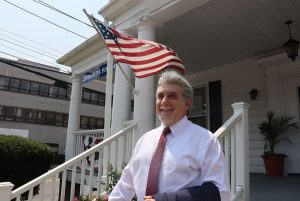
JUSTIN BRASCH LEONARD LOLIS
Auditorium
Hear from Mayoral Candidates. Sponsored by the League of Women Voters of White Plains in partnership with the NAACP of White Plains/Greenburgh. Read on for instructions on how to submit a question.
Hits: 103

130 FLOCKED TO THE THE 30TH ANNIVERSARY OF THE WHITE PLAINS LIBRARY FOUNDATION CELEBRATING THE FOUNDATION, THE LIBRARY AND “SATURDAY NIGHT LIVE”
SALUTING 50 YEARS OF “SATURDAY NIGHT LIVE” ITS CREATOR LORNE MICHAELS
WITH HIS BIOGRAPHER AND GUEST AUTHOR SUSAN MORRISON
WRITER OF THE BOOK “LORNE: THE MAN WHO CREATED SATURDAY NIGHT LIVE”
WPCNR ON THE TOWN DOWNTOWN By John F. Bailey. October 19, 2025:
It wasn’t a Gala. It was a 30TH Anniversary with 130 of White Plains Who’s Who, Who Supports, Who is, Who Love the White Plains Public Library staged by the White Plains Library Foundation.
The occasion: the recognition of the Foundation’s 30th year since it was suggested by former Library Director, Sandy Miranda.
The Foundation 30th anniversary coincided with the 50th anniversary on October 11, 1975 when that American entertainment institution, Saturday Night Live, the program that was not just comedy but a comedy reality check every week for 5 decades. It has amused America hilariously coast to coast and delivered truths and realities with what Mr.Michaels called “The Big Laugh.”
Ms. Morrison said “Lorne,” was always in search of the big laugh which made the writing and the performance of the a joke or skit “work.” The Big Laugh is still a big star for 50 years after it premiered on NBC and is still on the air.
In my opinion the humor on SNL is most always funny, and laugh-out-loud funny even when silly or actors spell-binding lampoons of the rich and powerful personalities, in spot-on impressions of household known personalities showed the truths behind public figures.
The White Plains Library Foundation frequently honors authors at its events and this year the perfect Guest was Susan Morrison writer of Lorne, The Man Who Created Saturday Night Live.
Her book tells in a clever progression of events uniquely presented with enough inside reveals to satisfy the never-miss-an-SNL fan while portraying a real eye-opening picture of what it takes to make a hit show every week from a man who did it.
Ms.Morrison had the audience glued to her every word as she explained the secrets of how Lorne Michaels started and ran SNL and produced it for 50 years was the natural choice.
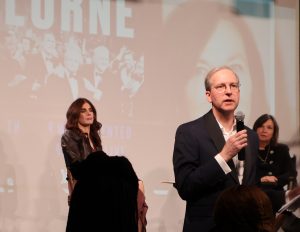
Graham Trelstadt, (above) President of the White Plains Library Foundation , after a cocktail hour with very tasty hors d’oeuvres and jazz by the finger-snapping, head bobbing Library Jazz Band in the art gallery, welcomed the festive convivial gathering of believers in reading writing and real intelligence (never artificial) in the auditorium to hear the confidente Susan Morrison of Lorne Michaels whom she worked with for 10 years to write his story and that of the show.
Mr. Trelstadt explained why it is important to support the White Plains Library Foundation:
“The Foundation exists to provide private support to the publicly funded library. We raise funds that leverage the phenomenal support the Library gets from the Common Concil and State sources. The funds we provide to the library allow for innovation and flexibility. They give the Library Director and her staff opportunities to respond to changing needs or brilliant ideas between budget cycles.
Over 30 years the Foundation has been in existence we have served the catalytic seed for exciting new programs (which can be found on the Library website), for innovative equipment like the Igloo, or the 3D printer in The Edge.
We have helped to complete three significant capital projects in the Trove, the Edge, and the Hub.”
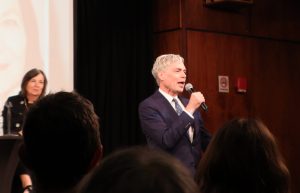
With Ms. Morrison at left, White Plains Mayor Thomas Roach thanked the guests for supporting the White Plains Library and reminisced how his mother took him to the library in his home town. Mayor Roach has spearheaded the improvements in the library The Trove, The Edge and the Hub.

Then it was “Saturday Night Live on stage” with the editor turned author for the first time, Susan Morrison (right) in conversation with Foundation Vice President Jessica Rao Lonski, (left) award-winning journalist and media professional with contributor roles at CNBC and Gannett, and communications for Fortune 500 companies.
Ms. Lonski asked short questions that enthused Ms. Morrison and smoothly drew out fascinating Morrison insights into the key structure of the writing of “Lorne” that Ms. Lonski said read like a novel.
Morrison’s secret:
the book is structured around the unfolding of every sequence of the events of a 7-day week of producing one Saturday Night Live program.
Ms. Morrison revealed the show is rigorous, fraught with anxiety of new cast members about being retained after the summer for the fall season.
She revealed the secret of every successful supervisor as Lorne Michaels is– asking the performer or writer to get a real flavor or nuance to deliver the feeling the script or performance of the script intended.
The audience got a good dose of entertainment reality from Ms. Morrison:
Though Saturday Night Lives are fabulous fun to view, Mr. Michaels’ ability to wrangle writers and actors with psychology, sensitivity and precise definition of what he wants to achieve takes patience, rehearsal (and lots of it), doing it until you get it right. It is a tough demanding business.
He also, Ms. Morrison revealed, was terrible on meeting deadlines.
Lorne’s biographer confided this was her first book she had written herself.
When asked by a member of the packed auditorium how she liked being the editee instead of the editor, she shared a penetrating insight into getting the performance you want.
The editor and she had a lot of discussions about portions of the book, and Ms. Morrison found the discussions provided new perspectives she valued and helped the book. She observed that she took from having been edited, her editor gave her a new sensitivity to working with her own authors whom she edits.
Mr. Trelstad saluted highlights over the Library’s and the Foundation the last 30 years.
Sandra Miranda Library Director from 1989 to 2011. Brian Kenney Director from 2011 to 2024 when Mr. Kenney oversaw creation of The Edge for teens and The Hub in 2018 which reorganized services for adults. He welcomed Laura Eckley as new Library Director who started in October.
He recognized Lauren Candela-Katz. Libby Hollahan the first Executive Director of the Foundation from 2010-16.
Mr. Trelstad praised Nancy Rubini recently retired Foundation Executive Director in the 9 years 2016-2025. “We couldn’t be here today without the skills and passion you each brought to your work.”
Mr. Trelstad closed with a look into the Library’s future:
“Now more than ever, as challenges to public funding of libraries and other cultural institutions become more significant and real , we need your continued support to keep the White Plains Library the great community institution that it has become.”

Congressman George Latimer mingling with the White Plains Councilman Richard Payne as Congressman Latimer shared recent highlights in Washington.

The Library Jazz Band was not quite they were in the groove with jazz that was cool and and got the evening off to a rousing start
Hits: 101

THE GARAGE COLLAPSE–WHAT DOES THIS MEAN?

THE PLAYLAND BURGLARY

GOVERNOR CONSOLIDATES HOSPITALS

SALUTE TO THE CON ED MEN AS POWER POLES ARE REPLACED AROUND TOWN
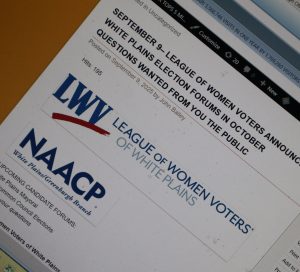
HERE COME THE FORUMS FOR COUNTY EXECUTIVE RACE,
MAYOR’S RACE AND COMMON COUNCIL

ASSEMBLYMAN BURDICK— PUBLIC SERVICE COMMISSION NIXES PUBLIC HEARING ON CON ED RATES IN WESTCHESTER. WHAT IS THE STATE LEGISLATURE THINKING? HOW YOU CAN STILL COMMENT

MGM GRAND RESORTS WITHDRAWS FROM EMPIRE CITY CASINO PROJECT

BALLYS PROPOSAL WINS BRONX APPROVAL
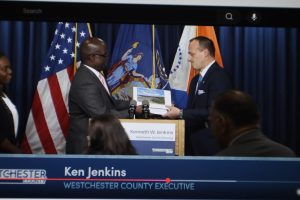
COUNTY EXECUTIVE JENKINS SUBMITS CAPITAL SPENDING BUDGET UP 8%
PLUS IMPACTS ON HEALTH OF NATION CAUSED BY SHUTDOWN
BLEAK OUTLOOK FOR THOSE DEPENDENT ON MEDICAID
WHY HAS NOT THE STATE PREPARED CONTINGENCY PLANS?
AND MORE WITH
JOHN BAILEY AND THE NEWS

THIS WEEK EVERY WEEK
ON WHITE PLAINS WEEK
FOR 24 YYEARS
Hits: 427

Health Care Safety Net Transformation Program Mobilizes State Investments To Improve Resilience of Safety Net Hospitals
Over $2.6 Billion in Investments Awarded To Ensure Access to High Quality Health Care for More New Yorkers Across the State
Governor Kathy Hochul Thursday unveiled transformative investments in six new partnerships between safety net hospitals and health care organizations under the Health Care Safety Net Transformation Program, totaling over $2.6 billion in capital and operating dollars.
St. John’s Riverside and Montefiore Health System to merge
Westchester Medical Center, Bon Secours Charity Health System, and Health Alliance of the Hudson Valley combine
“The strength of our hospitals is a reflection of the strength of our communities, and safety net hospitals play a critical role in providing quality health care to vulnerable populations,” Governor Hochul said. “Every person should have access to affordable, reliable health care regardless of the zip code they live in, and these investments will bring vital resources to underserved New Yorkers.”
Established in the FY25 Enacted Budget, the Health Care Safety Net Transformation Program incentivizes partnerships between safety net hospitals and health care organizations. Through this program, New York is encouraging partnerships with safety-net institutions by providing strategic capital and operating support, in addition to required regulatory flexibility, to improve the resilience and sustainability of safety-net hospitals and expand access to high quality care. Earlier this year, the Governor announced the first eight projects under this program.
New York State Health Commissioner Dr. James V. McDonald said, “I want to thank Governor Hochul for her steadfast commitment to strengthening health care in New York. Safety net hospitals are the backbone of care for vulnerable and underserved communities across our state. Through these strategic investments and partnerships, we are not only stabilizing these hospitals but also building a foundation of resilient and sustainable health services that will ensure access to high-quality care for all New Yorkers for years to come.”
The Department of Health will work closely with these applicants to effectuate their proposed transformation plans and improve access to high quality health care across the state.
Breakdown of Investments In the other 4 Safety Net Hospitals
Arnot Ogden Medical Center and Cayuga Health
Crouse Hospital and Northwell Health
Erie County Medical Center and University of Buffalo Physicians Group
Maimonides Medical Center and NYC Health + Hospitals
Hits: 110
WPCNR THE LETTER TICKER. OCTOBER 17, 2025: